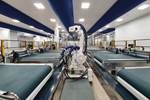Spirit Aerosystems converts to 100% renewable wind energy in Kansas headquarters
Leading Tier 1 Supplier of composites increases global renewable power usage to 75% toward 30% reduction in its greenhouse gas emissions by 2030.

Photo Credit: Getty Images
Spirit AeroSystems Inc. (Wichita, Kan., U.S.), a wholly owned subsidiary of Spirit AeroSystems Holdings Inc., has announced the conversion to 100% wind-generated electricity at the company’s headquarters in Wichita, Kan. This major energy transition is one of a number of initiatives accelerating Spirit’s transformation to more environmentally responsible operations.
“Harnessing a local renewable and reliable resource dramatically reduces our corporate carbon emissions, a key priority for Spirit in achieving our sustainability goals,” says Tom Gentile, president and CEO of Spirit AeroSystems. “Improving both our environmental and operational performance builds competitiveness in our business, which means we can continue to support our local economy and secure our long-term future in Kansas.”
The Spirit Wichita facility employs approximately 10,000 people and has 12 million square feet of manufacturing capacity where it builds fuselages and other aerostructures for Boeing (Chicago, Ill., U.S.), Airbus (Toulouse, France) and defense contractors. The conversion to Wichita’s facility increases Spirit’s global renewable electricity percentage to 75%.
“Renewable energy is a key component of our strategy to achieve a 30% absolute reduction in greenhouse gas [GHG] emissions from our operations by 2030,” adds Chris Ladwig, senior director and sustainability leader at Spirit AeroSystems. “Transitioning our Wichita site to 100% wind electricity greatly accelerates our ability to meet this target.”
Spirit Wichita’s wind power will come from 62 wind turbines that are part of a wind farm called Flat Ridge 3 in Kingman County that is owned and operated by a subsidiary of American Electric Power (Columbus, Ohio, U.S.). Spirit then has an agreement with Evergy (Kansas City, Mo., U.S.) which enables the company to purchase clean electricity at a competitive cost via a long-term contract, significantly increasing the operational efficiency of its largest global site.
“Our Flat Ridge 3 wind project adds more clean energy to AEP’s nearly 1,600-megawatt [MW] portfolio of competitive wind, solar and storage assets,” contends Greg Hall, executive vice president of Energy Supply, AEP. “This project not only supplies renewable energy to Evergy customers, but also provides valuable economic benefits, such as tax revenue and jobs, to communities in Kingman County.”
Related Content
-
Infinite Composites: Type V tanks for space, hydrogen, automotive and more
After a decade of proving its linerless, weight-saving composite tanks with NASA and more than 30 aerospace companies, this CryoSphere pioneer is scaling for growth in commercial space and sustainable transportation on Earth.
-
Honda begins production of 2025 CR-V e:FCEV with Type 4 hydrogen tanks in U.S.
Model includes new technologies produced at Performance Manufacturing Center (PMC) in Marysville, Ohio, which is part of Honda hydrogen business strategy that includes Class 8 trucks.
-
Polar Technology develops innovative solutions for hydrogen storage
Conformable “Hydrogen in a Box” prototype for compressed gas storage has been tested to 350 and 700 bar, liquid hydrogen storage is being evaluated.
















